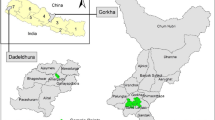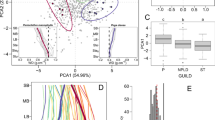Abstract
Key message
Functional branch analysis (FBA) is a promising non-destructive method that can produce accurate tree biomass equations when applied to trees which exhibit fractal branching architecture.
Abstract
Functional branch analysis (FBA) is a promising non-destructive alternative to the standard destructive method of tree biomass equation development. In FBA, a theoretical model of tree branching architecture is calibrated with measurements of tree stems and branches to estimate the coefficients of the biomass equation. In this study, species-specific and mixed-species tree biomass equations were derived from destructive sampling of trees in Western Kenya and compared to tree biomass equations derived non-destructively from FBA. The results indicated that the non-destructive FBA method can produce biomass equations that are similar to, but less accurate than, those derived from standard methods. FBA biomass prediction bias was attributed to the fact that real trees diverged from fractal branching architecture due to highly variable length–diameter relationships of stems and branches and inaccurate scaling relationships for the lengths of tree crowns and trunks assumed under the FBA model.






Similar content being viewed by others
References
Brown S (1997) Estimating biomass and biomass change of tropical forests: a primer. FAO Forestry Paper-134. FAO, Rome
Brown SAJ, Gillespie JR, Lugo AE (1989) Biomass estimation methods for tropical forests with application to forest inventory data. For Sci 35(4):881–902
Burgess I (1988) Provenance trials of Eucalyptus grandis and E. saligna in Australia. Silvae Genetica 37:221–227
Chave J, Riera B, Dubois M (2001) Estimation of biomass in a neotropical forest of French Guiana: spatial and temporal variability. J Trop Ecol 17:79–96
Chave J, Andalo C, Brown S, Cairns MA, Chambers JQ, Eamus D, Fölster H, Fromard F, Higuchi N, Kira T, Lescure J-P, Nelson BW, Ogawa H, Puig H, Riéra B, Yamakura T (2005) Tree allometry and improved estimation of carbon stocks and balance in tropical forests. Oecologia 145(1):78–99
Clark NA, Wynne RA, Schmoldt DL (2000) A review of past research on dendrometers. For Sci 46(4):570–576
Eloy C (2011) Leonardo’s rule, self-similarity and wind-induced stresses in trees. Phys Rev Lett 107:1–5. doi:10.1103/PhysRevLett.107.258101
Enquist BJ (2002) Universal scaling in tree and vascular plant allometry: toward a general quantitative theory linking plant form and function from cells to ecosystems. Tree Physiol 22:1045–1064
Gibbs HK, Brown S, Niles JO, Foley JA (2007) Monitoring and estimating tropical forest carbon stocks: making REDD a reality. Environ Res Lett 2:045023. doi:10.1088/1748-9326/2/4/045023
Henry M, Tittonell P, Manlay RJ, Bernoux M, Albrecht A, Vanlauwe B (2009) Biodiversity, carbon stocks and sequestration potential in aboveground biomass in smallholder farming systems of western Kenya. Agric Ecosyst Environ 129:238–252
Kuyah S, Dietz J, Muthuri C, Jamnadass R, Mwangi P, Coe R, Neufeldt H (2012) Allometric equations for estimating biomass in agricultural landscapes: I. aboveground biomass. Agric Ecosyst Environ 158:216–224
Mäkelä A, Valentine HT (2006) Crown ratio influences allometric scaling in trees. Ecology 87(12):2967–2972
Ozier-Lafontaine H, Lecompte F, Sillon JF (1999) Fractal analysis of the root architecture of Gliricidia sepium for the spatial prediction of root branching, size and mass: model development and evaluation in agroforestry. Plant Soil 209:167–180
Rousseeuw PJ (1984) Least median of squares regression. J Am Stat Assoc 79(388):871–880
Salas E, Ozier-lafontaine H, Nygren P (2004) A fractal root model applied for estimating the root biomass and architecture in two tropical legume tree species. Ann For Sci 61:337–345
Santos-Martin F, Navarro-Cerrillo R, Mulia R, van Noordwijk M (2010) Allometric equations based on a fractal branching model for estimating aboveground biomass of four native tree species in the Philippines. Agrofor Syst 78:193–202
Shinozaki K, Yoda K, Hozumi K, Kira T (1964a) A quantitative analysis of plant form—the pipe model theory I. Basic analysis. Jpn J Ecol 14:97–105
Shinozaki K, Yoda K, Hozumi K, Kira T (1964b) A quantitative analysis of plant form—the pipe model theory II. Further evidence of the theory and its application in forest ecology. Jpn J Ecol 14:133–139
Smith DM (2001) Estimation of tree root lengths using fractal branching rules: a comparison with soil coring for Grevillea robusta. Plant Soil 229:295–304
Souter NJ, Watts RA, White MG, George AK, McNicol KM (2010) A conceptual model of tree behaviour improves the visual assessment of tree condition. Ecol Ind 10:1064–1067
Van Noordwijk M, Mulia R (2002) Functional branch analysis as tool for fractal scaling above- and belowground trees for their additive and non-additive properties. Ecol Model 149:41–51
Van Noordwijk M, Purnomosidhi P (1995) Root architecture in relation to tree-soil-crop interactions and shoot pruning in agroforestry. Agrofor Syst 30:161–173
Van Noordwijk M, Spek LY, De Willigen P (1994) Proximal root diameter as predictor of total root size for fractal branching models I. Theory. Plant Soil 164:107–117
West P (2009) Tree and Forest measurement, 2nd edn. Springer, London
West GB, Brown JH, Enquist BJ (1999) A general model for the structure and allometry of plant vascular systems. Nature 400:664–667
Wiemann MC, Williamson GB (2011) Testing a novel method to approximate wood specific gravity of trees. For Sci 58(6):577–591
Zeide B (1998) Fractal analysis of foliage distribution in loblolly pine crowns. Can J For Res 28:106–114
Acknowledgments
The authors would like to thank the World Wildlife Fund and the Global Environmental Facility of the United Nations, members of the Carbon Benefits Project at Michigan State University and ICRAF offices in Kisumu and Nairobi, Kenya, without whose support the data used in this study would not have been generated. The authors would also like to thank two anonymous reviewers for suggestions to improve the quality of this manuscript.
Conflict of interest
The authors declare that they have no conflict of interest to report regarding this submission.
Author information
Authors and Affiliations
Corresponding author
Additional information
Communicated by E. Priesack.
Rights and permissions
About this article
Cite this article
MacFarlane, D.W., Kuyah, S., Mulia, R. et al. Evaluating a non-destructive method for calibrating tree biomass equations derived from tree branching architecture. Trees 28, 807–817 (2014). https://doi.org/10.1007/s00468-014-0993-2
Received:
Revised:
Accepted:
Published:
Issue Date:
DOI: https://doi.org/10.1007/s00468-014-0993-2




